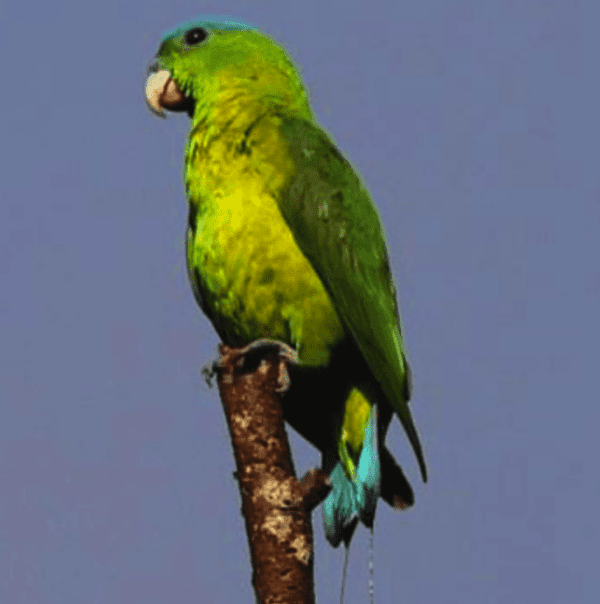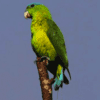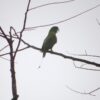Blue-crowned Racquet-tailed Parrot
Also known as:
Blue-crowned Racquet-tail
Also known as:
Blue-crowned Racquet-tail

Prioniturus

discurus
Size:
27 cm (10.5 in)
Weight:
140-160 g (4.9-5.6 oz)
Subspecies including nominate:
two: P.d. discurus, P.d. whiteheadi
Colour Adult:
In general, green body, bright emerald green on face.
P.d. discurus: Both adults-crown to nape deep blue; centre tail feathers green, “racquets” black tinged with blue, outside tail feathers blue edged with green and tipped with black. Beak blue/grey.
P.d. whiteheadi: Both adults-less blue on crown, blending into green on rest of head.
Colour Juvenile:
P.d. discurus: As in adult but with little or no blue on crown; no long tail shafts.
Call:
Harsh and rasping screeches; also squeaky notes similar to other Prioniturus sp.
Xeno-canto Wildlife Sounds-Blue-crowned Racquet-tailed Parrot
More Information:
Content Sources:
CITES
BirdLife International
Cornell Lab of Ornithology/Birds of the World
Parrots: A Guide to Parrots of the World, Juniper and Parr, 1998
Parrots of the World, Forshaw and Cooper, 1977, 1989. 2010 edition
Parrots of the World, Forshaw, 2006.
Parrots: Their Care and Breeding, Low, 1986.
Captive Status:
Not found in captivity.
Longevity:
—
Housing:
—
Diet:
Not recorded.
Enrichment:
—
Nest Box Size:
—
Clutch Size:
Not recorded.
Fledging Age:
—
Hatch Weight:
—
Peak Weight:
—
Weaning Weight:
—
World Population:
Unknown but reported as generally common, stable.
IUCN Red List Status:
Least Concern
CITES Listing:
Appendix II
Threat Summary:
Not globally threatened. Population is thought to be stable but remains unknown. Trapping for the wild bird trade could become a concern. This species is considered to have a medium dependency on forests, and tree cover is estimated to have declined by 7.5% within its range over the past three generations. As a precautionary measure, it is tentatively suspected that the forest loss may have led to a 1-19% decline in the species’ population size over the same time frame.
Range:
P.d. discurus: Jolo in Sulu Archipelago, and Balut, Mindanao, Olutanga, and Basilan, S Philippine Islands.
P.d. whiteheadi: S Luzon, Catanduanes, Tablas, Ticao, Sibuyan, Masbate, Samar, Biliran, Leyte, Cebu, Bohol, Guimaras and Negros, in the N to C Philippine Islands.
Habitat:
Found in primary and tall secondary growth, forest margins and remnant trees in cultivated areas. Up to 1750 m (5740 ft).
Wild Diet:
Not well known, but includes bananas and possibly Ficus and Sibuyan foodstuffs.
Ecology and Behaviour:
Seen in small noisy groups of five to a dozen birds outside the breeding season. Groups converge to feed in fruiting trees. Resident, but disperses after breeding season.
Clutch and Egg Size:
Rounded eggs, 31.5 x 26 mm (1.2 x 1.0 in); clutch size unknown.
Breeding Season:
April-May in Negros; May in Leyte; April in Mindanao. Nesting is thought to be colonial in large trees, in limb or trunk hollows.
Related Links:
—



